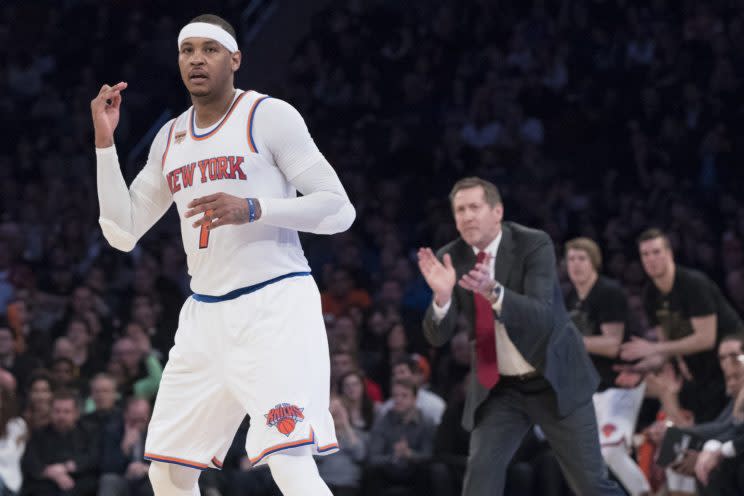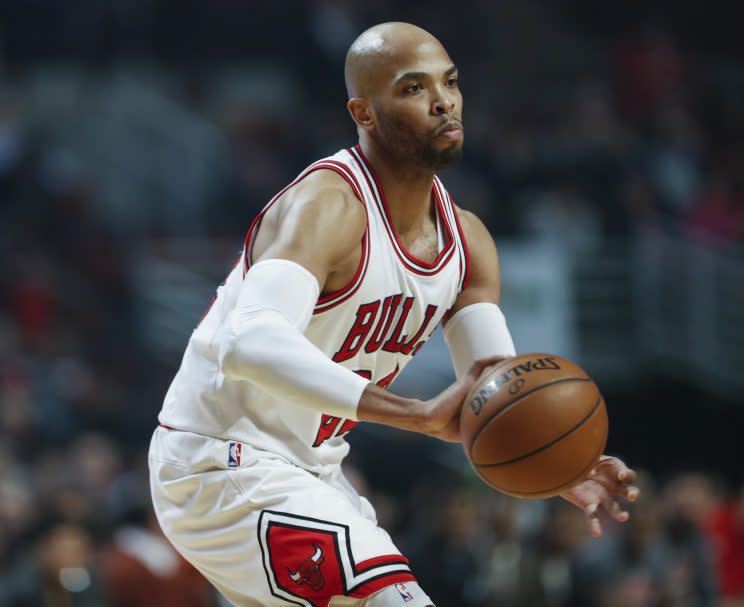Trade guide: The task of moving Carmelo Anthony
The Vertical Front-Office Insider Bobby Marks, a former 20-year executive with the Nets, looks at each team’s roster and trade assets, as well as examining the track record of each team’s general manager during previous trade deadlines.
Previous trade guides: The title contenders | West teams pushing for playoff spot | East teams eyeing home court | Teams that shouldn’t focus on playoffs | Rebuilding teams with limited assets | Teams built through the draft
A look at two big-market teams dealing with adversity this season as the Feb. 23 deadline approaches.
NEW YORK
Roster
Player Value Insider Info
1. Kristaps Porzingis Franchise
2. Carmelo Anthony Core No-trade clause
3. Derrick Rose Starter Expiring contract
4. Courtney Lee Starter
5. Willy Hernangomez Key reserve/development
6. Justin Holiday Rotation Expiring contract
7. Kyle O’Quinn Rotation
8. Brandon Jennings Rotation Expiring contract
9. *Joakim Noah Rotation
10. Mindaugas Kuzminskas Rotation/development
11. Lance Thomas Rotation
12. Sasha Vujacic Roster Expiring contract
13. Ron Baker Development RFA expiring contract
14. Maurice Ndour Development 2017-18 no protection
15. Marshall Plumlee Development 2017-18 no protection
*Best value is coming off the Knicks’ bench.
Trade assets
Exclude former draft picks Kristaps Porzingis and Willy Hernangomez, and the Knicks’ roster is void of trade assets.
Derrick Rose, Brandon Jennings, Courtney Lee and Joakim Noah would seem to have value on paper, but Rose and Jennings have expiring contracts and Lee and Noah have long-term deals. That makes teams hesitant of giving up valuable assets.
Lee’s value should increase this summer because of an average shooting guard free-agent market, rebuilding teams will have cap space, and Lee’s deal will only have three years left.
New York has a likely lottery pick along with the second-round picks from the Rockets and Bulls from previous trades.
The Carmelo Anthony situation
One would think that former All-Star Carmelo Anthony has the most trade value.
However, trading Anthony, who has a no-trade clause, is a serious challenge.
As the trade deadline approaches, the Knicks need to figure out whether the pool of teams Anthony would consider would grow in the offseason.
There will likely be a team that falls short of its championship expectations that might view Anthony as the missing piece.
Base compensation: Signed in the summer of 2014, Anthony is in the third year of a five-year max contract.
Both the no-trade clause and trade bonus were negotiated into the current contract.
2016-17: $24,559,380
2017-18: $26,243,760
2018-19: (ETO) $27,928,140
Trade bonus: Anthony has a 15 percent trade bonus that takes into account the amount owed on the contract, including the 2018-19 early termination year.
The bonus at the time of the trade deadline is $9,187,617.
The Knicks would pay Anthony the $9.1 million bonus, but for cap purposes the bonus is evenly divided and included in the 2016-17 and 2017-18 base compensation of the acquiring team.
The trade bonus could be amended to match salaries but only if a team is not hard capped.
Because Anthony has an early termination option, the bonus is not included in that year.
2016-17: $29,153,188
2017-18: $30,837,568
2018-19 (ETO): $27,928,140
Amount a team needs to send back: Because the Anthony contract counts as $29.15 million (trade bonus included), the acquiring team would need to send back $23.25 million in contracts (within 125 percent of Anthony’s salary plus $100,000).
In the case of the Clippers, who are $2.5 million below the hard cap, the combination of Jamal Crawford, Austin Rivers and Wes Johnson would work and still allow Los Angeles to sign two players to the minimum pro-rated salary and still stay below the hard cap.
The no-trade clause: The no-trade clause presents a double-edged sword.
Unlike the one-time trade bonus, the no-trade clause will carry to Anthony’s new team.
For the team acquiring Anthony, cap hits of $29.1 million, $30.8 million and $27.9 million present salary-cap challenges and roster imbalance in the future.
Front-office history at the deadline
Hired in March 2014, president Phi Jackson has made 10 trades in his tenure.
Jackson, however, remains a novice when it comes to making trades in mid-February.
The lone trade the Knicks have made at the deadline was acquiring Alexey Shved and two second-round picks (2017 and 2018) from Houston in exchange for Pablo Prigioni in 2015.
Post-trade deadline roster movement
The Knicks have 15 guaranteed contracts.
New York has only the prorated minimum exception to use if a roster spot is created.
CHICAGO
Roster
Player Value Insider Info
1. Jimmy Butler Franchise
2. Dwyane Wade Top starter 2017-18 player option
3. Taj Gibson Starter Expiring contract
4. Robin Lopez Starter
5. Doug McDermott Starter
6. Nikola Mirotic Rotation RFA expiring contract
7. Cristiano Felicio Rotation RFA expiring contract
8. Rajon Rondo Rotation 2017-18 $3M protection
9. Michael Carter-Williams Rotation RFA expiring contract
10. Jerian Grant Rotation
11. Bobby Portis Rotation
12. Paul Zipser Rotation/development
13. Isaiah Canaan Roster 2017-18 no protection
14. Denzel Valentine Development
Trade assets
The Bulls’ most valuable asset, besides Jimmy Butler, is Taj Gibson’s expiring contract.
The durable Gibson has missed only two games this year and can either start or come off the bench.
The Bulls also have seven players on their rookie contracts who have been drafted in the first or second round.
Each player – including Michael Carter-Williams, who is in his fourth year – is still in the developmental stages of his career and is best coming off the bench.
Chicago has its own first-round pick in June along with the Kings’ top-10 protected first.
If the season ended today, the Kings would retain their first and Chicago would receive Sacramento’s second-round pick in June (projected to be No. 39).
The Bulls’ second-round pick this year was traded to New York as part of the Derrick Rose transaction.
GM history at the deadline
Gar Forman has made four deadline trades since taking over in 2009.
Two of those trades resulted in Doug McDermott and Nikola Mirotic.
Starting in 2010, former lottery pick Tyrus Thomas was shipped to Charlotte for a 2012 protected first-round pick.
With Charlotte mired in the lottery in 2012 and 2013, Chicago received the 16th overall pick in the 2014 draft after Charlotte made the playoffs. Chicago then made a trade with Denver to move up to No. 11 to select McDermott.
The Nuggets received the Bulls’ own first at No. 19 and the No. 16 from Charlotte, selecting Gary Harris and Jusuf Nurkic.
In 2011, Chicago traded James Johnson to Toronto in return for Miami’s 2011 first-round pick (acquired in the Chris Bosh trade).
Four months later, Chicago moved the 28th overall pick along with the draft rights to Malcolm Lee to Minnesota in return for the Timberwolves’ No. 23 overall pick.
Mirotic was selected and joined the Bulls before the 2014-15 season.
Post-trade deadline roster movement
The focus will be on point guard Rajon Rondo as the March 1 waiver deadline approaches.
Although Rondo was a buyout candidate weeks ago, the veteran has anchored the Bulls’ second unit recently.
Any buyout talks with Rondo would present a shift in management’s philosophy, moving from a team eyeing the playoffs to one focusing on youth and development.
The Bulls have 14 guaranteed contracts and have the pro-rated room mid-level available.
More on Yahoo Sports:
• Germans furious after U.S. plays Nazi anthem at Fed Cup
• Patriots eye Super Bowl repeat with new slogan … and it’s bad
• Derek Jeter is expecting his first child
• Will Raiders’ greed kill Las Vegas stadium deal?




